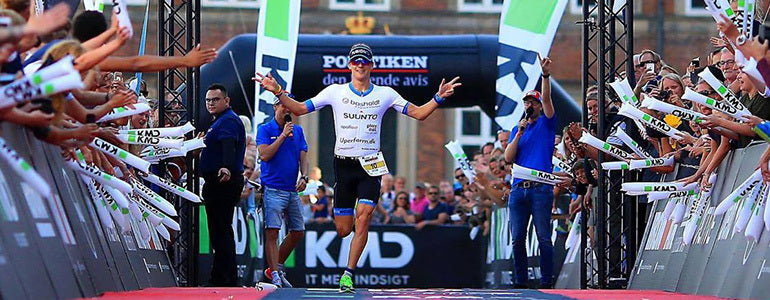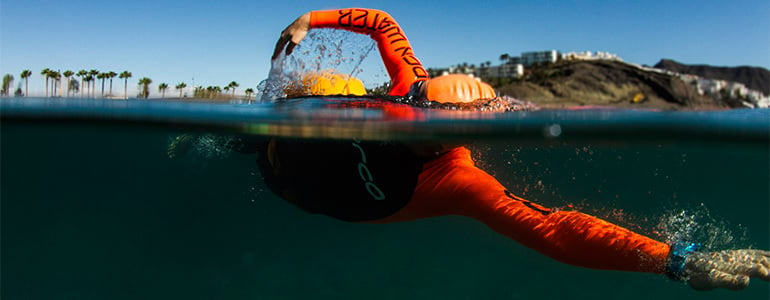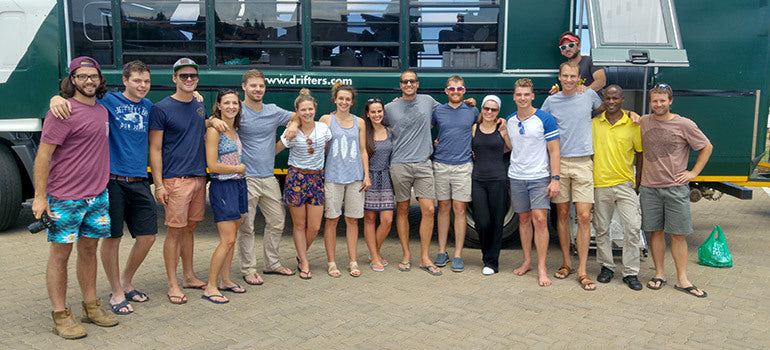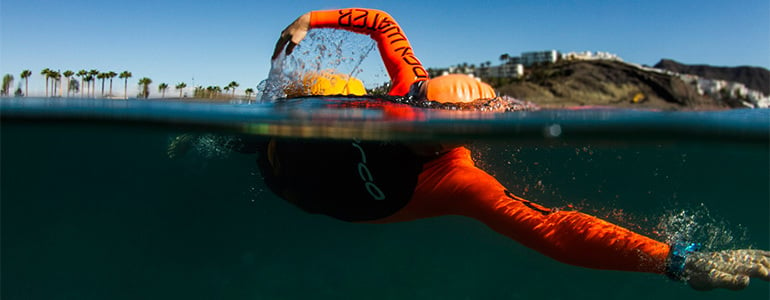

Suunto Blog

Training for the love of it
Suunto athlete Patrik Nilsson was a long distance runner, but it didn’t satisfy his desire to train. Then triathlon found him, and now he’s one of the fastest in Ironman history. © KMD IRONMAN DenmarkAt this year’s KMD Copenhagen Ironman, 25-year-old professional triathlete Patrik Nilsson had his mind set on one thing – having fun – but he achieved much more. He came first, smashed his own best time by 20 minutes and got the seventh fastest time in the history of Ironman: 07h49m18s. “It was the perfect day,” he says. “In Denmark it’s so open, and flat, and close to the sea so there’s always wind, but that day there was no wind. When we did the swim it was all flat, no waves at all. The conditions and course were perfect for a really fast day.” Only one year ago, Patrik wasn’t in such good form. Personal difficulties with his then coach were adversely affecting his training and outlook. It all came to a crunch at Ironman Cozumel 2015. He was in first position, with only 10km of the run remaining. But he was hating it so he quit and walked home. “To do well in races, you need to have fun,” he says. “That’s why I couldn’t run those last 10km; when it starts to get tough, you need to feel that it’s fun, and that’s what I felt again in Copenhagen.” © KMD IRONMAN DenmarkFrom Stockholm, Sweden, Patrik has lived to train since he was a kid. At school, he competed at a high level in long distance running, but it didn’t quench his thirst for training. He did his first triathlon in his last year at high school and finally found a worthy outlet for his energies. “With triathlon, there’s always something you can train,” he says. “If you can’t develop your running, maybe you can work on the swim or the bike. There are so many aspects. That’s what inspired me.” Patrik is currently training for Ironman Barcelona 2016. If he performs well, he’ll qualify for the Kona world championships in 2017. He’s working with a new coach, who also happens to be his girlfriend. “It’s good to have a close connection with my coach, which is easy when the coach is your girlfriend,” he says. “It makes it really easy for her to understand how I’m feeling. “There have been a lot of small things we’ve been trying to work on. One of the biggest was around my mentality – to make sure I’m having fun and really enjoying it. It’s worked out perfectly.” While he enjoys pushing his limits with racing, Patrik doesn’t overdo it. Training is what he loves and that’s the focus for most of the year. “For me, it’s better to have one, two or three months of really good training and then do one race and go really hard,” he says. “The most important thing is to have fun. “In Copenhagen I really felt it was fun, I really enjoyed standing on the beach next to the guys and saying, ‘I’m really going to beat you, I’m going to kick your ass and this is going to be fun’. That gives triathlon something more than just the expectation you should win.”
Stay tuned for part two of series about Patrik!
MAIN IMAGE: © KMD IRONMAN Denmark
Swimming the wild open waters
In the second installment of our “Community” series, we travel to Barcelona, Spain, to connect with a unique group of open-water swimmers whose explorations are made in the mystery of the sea.
The popularity of open-water swimming has increased considerably over the last decade. The real catalyst for growth in the sport is its close-knit community of swimmers and the connection they share for exploring wild open waters.
The sea is an unpredictable, and at times tempestuous environment to navigate, asserts David Campà. He is the technical director of Marnaton, an organization that coordinates open-water swims and races in a number of stunning locations along Spain’s picturesque coastline. Its mission is to build awareness for the sport and encourage water enthusiasts of all ages and abilities to join the burgeoning open-water community. Last year more than 4000 participants joined the four open water races Marnaton organized through the spring and summer seasons. The races range from 2 km to 7 km and always include a challenge for kids.
While open-water swimming seems like an individual sport, the reality is quite the opposite. As Campà describes, “unlike any other sport, open-water swims are never the same. The fog, waves, wind, currents and marine life come into play to draw a new route every time.” The sea is an unpredictable domain and swimming buddies are vital.
There is an inherent vulnerability to the individual swimmer that necessitates partnership and always will, regardless of experience. It is the manifestations of nature that forge the most immediate bonds amongst swimmers. At any particular moment they are at the whim of the sea, and the elements. The sea doesn’t care if it is a race or the first swim of the year. The open water is the wilderness, a realm that requires consideration and preparation, and depends intrinsically on camaraderie.
Rarely are challenges and fears overcome, personal bests achieved or the unprecedented experienced without community. Oftentimes its influence is intangible and emotional, and almost without exception its impact transformational.
Read also
RUNNING WITH A COMMON GOAL
SIX USEFUL TIPS FOR SWIM-RUNNING
8 TIPS FOR OPEN WATER SWIMMING

7 spring training camp tips for triathletes
Top triathlete Åsa Lundström shares 7 tips to help you get the most from your spring training camp. © OrcaSuunto athlete Åsa Lundström has been putting in 35-hour training weeks at a spring training camp at the Playitas Resort on the Canary Islands. She came fourth at the recent South Africa Ironman, qualifying herself for the World Championship in Kona, Hawaii this October – her main goal this year. Åsa says going to a spring training camp somewhere warm allows people from colder climes to boost their training volume to prepare for the coming season. “Most long distance triathletes have the Kona Ironman as their main goal and in order to elevate our base level we need to have a big training block and a spring camp is a really good way to achieve that,” Åsa says. “Most triathletes want to boost their cycling at spring camps because that's the hardest discipline to train at home during the winter months.”© Orca
Don’t overdo it
When you’re at a camp there are so many motivated people and groups it’s easy to get carried away. If you plan to start out with a three-hour ride and you go with someone who wants to do a four or five hour ride, it's very easy to get pulled along with them. Unsurprisingly, it’s not uncommon for people to train too hard and crash their immune system and then go home, catch a cold and not be able to train for two weeks. Being patient and not getting carried away is probably the hardest part of being on a camp.© Orca
Stick to your plan
Create a training plan for the camp with your coach before you leave so you have a clear idea of what you’re going to do. This helps you to avoid overdoing it. Of course if you feel fresh and you feel strong it’s important to push a bit harder. You need that to stay motivated and to get the endorphins. But still don't get carried away and overdo it. The risk is you will hit the wall.
Rest and eat well
Most people train a lot more at a camp than they do at home. They go to boost their training. It's important to remember then that you need more sleep and to take good care of your nutritional intake by eating good quality food. At the beginning of a camp you are so filled with endorphins and energy and you’re in the warm sunshine, it’s easy to feel like you don’t need so much sleep. Even if you’re only on a one-week training camp it’s important to get eight or nine hours of sleep every night even when you feel you don’t need it.© Åsa Lundström
Take your nutrition
If you’re going to a training camp where you haven’t been before it can be difficult finding the sports nutrition you use for your training. So if you don't know what you can get there, make sure to bring enough of your own.
Find a buddy
Training with a buddy, or even just around other triathletes, means you can push yourself to a higher level. If you train for many hours it’s always good to have a partner. If you have someone who is at your level, it’s a constant source of motivation because you will be racing against these people.
© Åsa Lundström
Foam roll and stretch
I go to the gym to workout, stretch properly and do foam rolling. I do it as prevention. A light massage half way through a camp is a good thing. Avoid deep massage because that can make your muscles sorer and they might need a rest afterwards.
Focus on volume
Most people go on a spring training camp because they can’t get the volume in at home because it’s too cold. So the natural thing is to do the volume training, which is cycling and running. Take the opportunity to do longer sessions. It’s also a good time to practice open water swimming if you’re somewhere where the water temperature is nice. Don’t focus on technique, but build strength and practice navigating.
Lead image: © Orca/Gines Diaz

Leadership lessons from an adventure-racing champion
Nathan Fa’avae is the captain of Team Seagate, a world champion adventure racing team. He knows both sides of endurance sport – individual and team competition – but is renown for his ability as a team captain. We caught up with the New Zealander to find out what it takes to build a winning team. Adventure racing has taken Nathan around the world. © Nathan Fa'avaeWhite-water and sea kayaking, climbing, caving, orienteering, trail running, trekking, road cycling, mountain biking, ski touring – Nathan Fa’avae does it all. If the lifelong adventure junky isn’t doing one of the above, he enjoys taking his children on adventures in New Zealand’s stunning wilderness. The 43-year-old has been a semi and full time professional athlete for 16 years and competed in 12 world championships. Remarkably he has done so while battling a heart condition that he’s had surgery for three times. His role as the captain of Team Seagate, which dominated the adventure-racing scene for years, has earned Nathan wide respect as a leader. Any big races in 2016? I’m not sure what racing I’ll do in 2016 and beyond, if any. I’m always fit and active, I love the sport but I’ve done a lot of it. I’m an adventurer so that’s a lifestyle for me, not something I’ll stop doing.
Team Seagate has one multiple adventure racing world championships. © Nathan Fa'avae
Why do you enjoy about team competition?
With the team racing I like the fact we battle together, as a stronger united force. It’s nice to be on the start line with friends and know we’re in this thing together. I get strength and courage from that. How do you see team versus individual competition? As an individual you can control your pace to suit, if you want to ease up, go harder, whatever, but in a team you’re dictated by the speed of the team. The support and camaraderie of a team often makes the major challenges more enjoyable and achievable.
Nathan has paddled in 15 countries and many exposed situations. © Nathan Fa'avae
How do you manage with team dynamics? As a team captain, accommodating and nurturing people to get the best out of them is an important role. My strength in captaining teams is communication and composure. I place high value on open communication and not sweating the small stuff. I try to see everything in a positive light and always look for solutions to problems.
Cross-country mountain biking was his first competitive sport. © Nathan Fa'avae
How do you choose your teammates? Building a team is about matching people who will add value to one another’s skill sets. Team work and unity spirals up if you get that mix right, blending together like-minded people with similar attitudes. It’s important we enjoy being together, socially and competitively. For me personally, I tend to only race with people I truly consider friends, people I respect and trust. That’s how I choose my teammates.
Part of adventure racing is dealing with the unknown – how do you deal with that?
I think our team has always dealt with the unknown because we always expect it. In adventure racing, the thing you have not planned for is going to happen, so you need to be flexible and adaptable, roll with things and not get worried and stressed. My motto is ‘nothing can shock me’, that means when we get last minute surprises, they’re never actually a surprise.
© Nathan Fa'avaeDo teams make better decisions in the outdoors or individuals? There’s no hard and fast answer to this question. From my experience, I feel safer in the outdoors on my own. I know my limits and capabilities and act accordingly. The close calls I have seen were in groups when group culture meant they did something dangerous they wouldn’t have done as individuals. People do tend to show off in front of other people and subsequently take more risks.

THE TRAVERSE ACROSS A MOUNTAIN KINGDOM HAS STARTED
The winners of our #DreamTraverse Video Contest set of on their week long traverse across Lesotho in Southern Africa today.
Grobler Basson and his friends from Cape Town, South Africa, have had the dream of traversing the central part of the Kingdom of Lesotho already for quite some time. Winning Suunto’s #DreamTraverse Video Contest’s 5.000 euro main prize in November gave their project a boost.
Today the team of 18 people started their traverse at Maliba Lodge, which is located in the northern part of Lesotho. The athletes completing the traverse while trail running, mountain biking, kayaking as well as swimming are Raoul Hamman, Hanmarie Stadler, Gustav Roberts, Charl Swart, Quintin van Heerden, Chris de Bruyn, André Joubert, Grobler Basson, Neelke Stadler and Vian Espost. In the documenting, logistics and support roles are Gideo Basson, Josh Rowe, Attie Stadler, Erika Basson, Karmien Joubert, Janine du Bruyn, Inge Basson and Joshua Oostuizen.
The team’s logistics crew is driving an overland truck that carries people, mountain bikes, kayaks and all the rest of the gear, food and filming equipment.
We talked to Grobler Basson just before the start.
How remote are the mountains of Lesotho?“The term ‘remoteness’ in the Lesotho mountains has a slightly different meaning. Even though we may see some herd boys high up in the mountains communication is desperate at best as my knowledge of the native language Sesotho is scary! As Lesotho is a full on third world country, medical assistance would preferably be sought in South Africa which is a 5 to 7 hour drive by car when picked up on a viable road.“
Are you following an existing route or are you taking your own way across the Mountain Kingdom?“The least amount of known routes possible was our outset from the start. However, during the mountain biking legs there will be some jeep track and even a small stretch of tarmac. The remainder of the route is unknown and new, we will be navigating these stages and following some game trails as well as trails made by the local heard-boys. On the first and last trail running stages we will traverse large ridgelines where no paths exist.
How long is the route?“The route is approximately 210km. According to our route schedule, trail running should make up about 70km, mountain biking 110km, kayaking 28km and a couple of kilometres for swimming. However, as we will be navigating in some unknown territory, these figures are seen as mere guidelines!”
The trail running route on the first day will reach an elevation of 3200 meters.
What are the biggest challenges?“As Lesotho has been experiencing some severe drought, water during the long and remote stages becomes a concern. Navigational errors may see some of the athletes prolong their stages significantly. The weather is also a concern. Even though it is summer time, last month while competing in the Salomon Skyrun about 180km from where we will start, it started snowing. Due to the high mountain climate, to under estimate the weather could pose significant danger.”
What will be the highlights of the traverse?“I think this traverse will be filled with some amazing highlights, but when all is said and done and our bodies start to show the miles, to look back and say I experienced this with my closes friends is priceless. It is something that money can’t buy. We truly believe life is better in a team!”
Follow the Kingdom Traverse project also at kingdomtraverse.co.za

THE ROAD TO KONA IRONMAN: STEP FOUR: RELIVING THE RACE
With heat of the day soaring to 35° C, it was one of the hottest races in the history of the Kona Ironman. Suunto ambassador Åsa Lundström gave it everything she had and improved her placement by six positions from last year. We caught up with her for the final instalment of our four part series about her road to Kona.
© OrcaHer goal was to finish in the top 15, no small feat at the world’s premier Ironman. Placing 11th, Swedish triathlete Åsa Lundström achieved this and says she’s confident she can do even better next year. “After learning several lessons from last year’s race, I had a better strategy for this year’s,” she says. “I know also I still have a lot of unused potential, both in terms of my physical capacity and from a strategic point of view.” To prepare for the Kona Ironman in Hawaii and the race’s humid conditions, she spent the prior three weeks training in the Canary Islands. “I was alone for the first week in Kona, which was pretty good for mental preparation, and a few days before the race my parents came to support me, which was incredibly valuable.”
Click to learn about the Kona Ironman!
© Orca
Mental preparation is an important aspect of her training and focus on race day. Åsa visualizes potential race day scenarios and how she would handle them if they did occur. She has a list of mantras and other mental techniques ready to use when the going gets tough during the race. “I try to focus on my own performance, look back on what I have done in my training and believe I have done enough,” she says. While Åsa didn’t have the perfect race, she’s happy with the improvements she did make. Being more patient, focusing on her performance and not giving much thought to the performance of other athletes were important lessons. “I learnt that cooling myself on the bike and run is on of the biggest factors that affect the outcome of the race,” she says. “Cold water under the helmet, over the body while cycling, ice in the sports bra, cold water sponges over the body and holding ice in the hands while running are useful methods to avoid overheating.”
Click here to read more about Åsa Lundström
© OrcaThe end of the road cycling leg was the most challenging part of Åsa’s race. Pedalling with tired legs into a strong head wind in hot conditions required all the mental toughness she could muster to get through. “There is much more to get out of my potential, and I’m already super psyched to start working to lift my level another couple of inches for next year’s Kona Ironman,” Åsa says. “Before I begin my off-season I will race in the Ironman 70.3 Middle East Championship in Bahrain in early December. “Thanks to all who follow and support my journey! It means more to me than you might think.”
Here are links to part one, part two and part three of our four part series on Åsa's road to Kona Ironman. Lead image: © Orca/Gines Diaz










































































